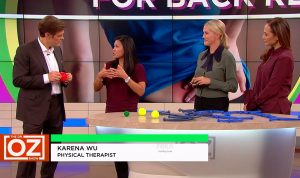 ActiveCare Physical Therapy, PC
ActiveCare Physical Therapy, PC
29 West 38th Street
Suite 601
New York, NY 10018

To Stretch or Not to Stretch
Hot off the presses – if it hurts, don’t do it! Since Jack La Lane first introduced the concept of fitness to the American public, we’ve been programmed to bend over and try to touch our toes as a prelude to exercise, gritting our teeth in pain as our hamstrings cry out in agony. More than 50 years later, research has debunked our tightly held beliefs about stretching before exercise, yet that information is taking some time to soak in.
Get in the lineup before any sort of 5K, 10K or half marathon, and you’ll see people bending over, touching their toes, doing all sorts of stretches to loosen up their muscles in preparation for the race. They seem to be oblivious to the latest research, which tells us that static stretching before exercise makes your muscles tighter, rather than looser. Several recent studies have concluded that static stretching before engaging in sporting activities actually leaves you weaker and slower.
Stretching before exercising sends warning signals to the brain that your muscles are in danger of becoming overstretched and injured, and your body’s response is to contract your muscles and become more tense. You are no longer able to move as freely and therefore rather than preventing injury you may actually be increasing your risk.
Instead of stretching, try warming up your muscles with a light jog before running, kicking a ball a bit before playing football or practicing a few serves prior to starting your tennis game. That type of movement actually incorporates dynamic stretching, which prepares your muscles for the same sort of performance they must produce during your workout, while increasing your heart rate and blood flow to the muscles, warming you up at the same time.
If you must stretch before a run, try monster kicks to loosen up those hamstrings. Stand and swing one leg straight forward and then switch to the other leg. This will ensure your hamstrings have increased blood flow, increased pliability and will reduce your chances of a cramp or tear if you overextend your leg during your run.
Stretching as a Workout by Itself
Stretching is still important, however, to maintain flexibility, an often neglected component of total physical fitness. The best time to stretch is during your cool down period after physical exercise, when your muscles are already warm and loose.
Stretching is also a good way to perk up during the day, when the mid-morning or mid-afternoon doldrums strike and you start to feel sleepy. Get up and go for a brisk walk, do some lunges, or if you can’t leave, do some gentle, dynamic arm, neck, shoulder and torso stretches right from your desk. It will get your blood flowing and leave you feeling revitalized and more energetic.
Stretching should always involve light, gentle, rhythmic movements, starting shallow and slowly progressing until you reach your full range of motion. If you’re new to stretching, have a physical therapist walk you through a dynamic stretching routine that will work for you.
The important thing to remember is that pain does not always lead to gain. If it hurts, maybe you shouldn’t be doing it. Stretching is a natural reflex, something we do automatically when we arise in the morning to gently bring our muscles to life and get the blood flowing. Any sort of a stretching routine should be relaxing, gentle and pleasant. As such, it should be the most enjoyable part of your physical fitness regimen, a soothing, pleasurable way to relax and wind down before bedtime. It will likely lead to a good night’s sleep and decrease your chances of getting muscle cramps during the night!
